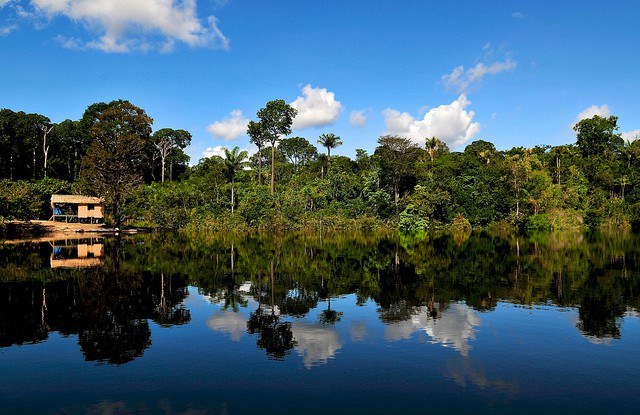
SAN JOSE, Costa Rica (22 July, 2013) — How is a raised garden of cassava plants deep in the Brazilian Amazon like the neck of an early European violin?
Both are products of traditional knowledge that has helped people adapt to a changing world since the dawn of humankind, said researchers at the Third Latin American Congress of the International Union of Forestry Research Organizations (IUFRO) in San José, Costa Rica.
As climate change threatens the livelihoods of forest people, scientists said they are tuning their ears to the myths, stories and songs with which people hand down traditional forest-related knowledge from generation to generation.
“There is growing awareness of the value and complementary roles of traditional knowledge and formal scientific knowledge,” John Parrotta, the U.S. Forest Service’s national research program leader for international science issues said in a presentation on during a panel discussion.
Traditional forest-related knowledge stems from people’s relationship with the land, which is an important part of their identity, said Parrotta, who is a member of IUFRO’s board of directors and co-editor, with Ronald Trosper of the University of Arizona, of “Traditional Forest-Related Knowledge: Sustaining Communities, Ecosystems and Biocultural Diversity,” which explores the ways in which people around the world use traditional knowledge.
That relationship leads to more sustainable ways of farming and using forest products, he said.
Miguel Pinedo-Vásquez, a scientist with the Center for International Forestry Research (CIFOR) has seen some of those practices first-hand in riverside communities in the Amazon.
“Smallholder production systems are inherently adaptable, because people have always had to deal with environmental variability and change in order to provide goods for their families,” Pinedo-Vásquez said in a presentation on “Forest Knowledge: An Amazonian Resource for Adaptation to and Mitigation of Climate Change.”
But the usual variability, such as the rise and fall of water levels in estuaries because of tidal cycles caused by the phase of the moon, is complicated by severe flooding caused by climatic phenomena such as El Niño, as well as human interference, such as the construction of hydroelectric dams upstream that change the natural flow of rivers, he said.
People find new ways to adapt to these uncertainties, changing their fishing habits to take advantage of freshwater shrimp that abound during flooding, when other species are scarce.
They also build wooden frames topped with platforms shaped like dugout canoes, where they plant everything from herbs to cassava. The diversity of crops is the same as in their fields, but the plants are safely above the reach of floodwaters, Pinedo-Vásquez said.
“How do people adapt to changes in flooding? They develop different systems of production,” he said. “The problem is that most programs that are designed to help people adapt to climate change focus on products, while the people themselves are looking for different forms of adaptation. They don’t expect one crop to solve their problems – it will be part of a larger system that also includes things like game animals, fish and forest products.”
So what does that have to do with violins?
People living in Amazonian communities are not the only ones who use traditional knowledge, said Marco Fioravanti, in his presentation on “Wooden Heritage as a Reference Source for Studies on Traditional Knowledge.”
Teasing clues from the design of items from religious statues to timber-framed houses to chairs, Fioravanti studies the way in which woodworking technology has changed in response to changing needs and conditions.
Early European woodworkers carved religious statues from solid tree trunks, emphasizing the front of the figure but leaving the back rougher, he said. But the style changed drastically during the Renaissance. In just 50 years, solid tree trunks went out of vogue, replaced by more detailed figures with glued-on limbs.
“The Renaissance put man at the center of history, so representation of the human figure – a 360-degree view – became vital,” Fioravanti said. “Woodworkers needed to produce a certain quality of the human body, even on the back of the sculpture.”
And the violin? That’s a little more complicated.
For half a millennium, European violin makers have fashioned the world’s finest violins from a combination of spruce and maple, and modern technology has not been able to improve on the sound those woods produce.
“There have been a lot of attempts to change these species, but traditional knowledge has been stronger than technological evolution,” Fioravanti said.
What has changed is the shape of the violin neck, which became more angled as musical forms and tastes changed, requiring stronger playing and higher notes.
“The type of music people were looking for was different, so they had to adjust the shape and angle of the neck,” he said.
Fioravanti has found clues about how people adapted to changing needs and environments in other wooden artifacts, ranging from houses to chairs.
“Wood is a repository of intangible knowledge, and wooden heritage is a repository of technological knowledge,” he said. “We can learn a lot from these solutions. Of course, we have to be able to transform that empirical knowledge into scientific knowledge.”
And that, Pinedo-Vásquez said, is an immediate challenge for scientists who study the way in which small farmers are adapting to their changing world.
For more information on the issues discussed in this article, please contact Miguel Pinedo-Vasquez at m.pinedo-vasquez@cgiar.org
This research was carried out as part of the CGIAR Research Program on Forests, Trees and Agroforestry.
We want you to share Forests News content, which is licensed under Creative Commons Attribution-NonCommercial-ShareAlike 4.0 International (CC BY-NC-SA 4.0). This means you are free to redistribute our material for non-commercial purposes. All we ask is that you give Forests News appropriate credit and link to the original Forests News content, indicate if changes were made, and distribute your contributions under the same Creative Commons license. You must notify Forests News if you repost, reprint or reuse our materials by contacting forestsnews@cifor-icraf.org.